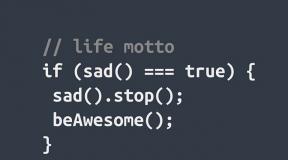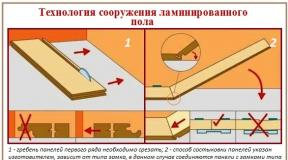Determination of the belt speed. Decoding ECG for Dummies Description of ECG
The electrocardiogram reflects only electrical processes in the myocardium: depolarization (excitation) and repolarization (restoration) of myocardial cells.
Ratio ECG intervals with phases of the cardiac cycle(systole and diastole of the ventricles).
Normally, depolarization leads to muscle cell contraction, and repolarization leads to relaxation. To simplify further, instead of “depolarization-repolarization”, I will sometimes use “contraction-relaxation”, although this is not entirely accurate: there is a concept “ electromechanical dissociation“, In which depolarization and repolarization of the myocardium do not lead to its visible contraction and relaxation. I wrote a little more about this phenomenon. earlier .
Elements of a normal ECG
Before proceeding to decoding the ECG, you need to figure out what elements it consists of.

ECG waves and intervals... It is curious that abroad the P-Q interval is usually called P-R.
Any ECG consists of prongs, segments and intervals.
TEETH- These are the bulges and concavities on the electrocardiogram. The following teeth are distinguished on the ECG:
P(atrial contraction)
Q, R, S(all 3 teeth characterize the contraction of the ventricles),
T(relaxation of the ventricles),
U(inconsistent tooth, rarely recorded).
SEGMENTS An ECG segment is called straight line segment(isolines) between two adjacent teeth. The P-Q and S-T segments are the most important. For example, the P-Q segment is formed due to a delay in conduction of excitation in the atrioventricular (AV) node.
INTERVALS The interval consists of tooth (complex of teeth) and segment... So spacing = prong + segment. The most important are the P-Q and Q-T intervals.

Teeth, segments and intervals per ecg. Pay attention to the large and small cells (about them below).
The teeth of the QRS complex
Since the ventricular myocardium is more massive than the atrial myocardium and has not only walls, but also a massive interventricular septum, the spread of excitation in it is characterized by the appearance of a complex complex QRS on the ECG. How to do it right highlight the teeth in it?
First of all, they appreciate amplitude (dimensions) of individual teeth complex QRS. If the amplitude exceeds 5 mm, the prong denotes capital (capital) letter Q, R or S; if the amplitude is less than 5 mm, then lowercase (small): q, r or s.
The tooth R (r) is called any positive The (upward) wave that is part of the QRS complex. If there are several teeth, the subsequent teeth indicate strokes: R, R ', R ", etc. The negative (downward) wave of the QRS complex, located in front of the R wave, is denoted as Q (q), and after - as S(s). If there are no positive teeth at all in the QRS complex, then the ventricular complex is designated as QS.

Variants of the qrs complex.
Normal tooth Q reflects depolarization of the interventricular septum, tooth R- the bulk of the ventricular myocardium, tooth S- basal (i.e. near the atria) departments interventricular septum... The R V1, V2 prong reflects the excitation of the interventricular septum, and R V4, V5, V6 - the excitation of the muscles of the left and right ventricles. Death of areas of the myocardium (for example, with myocardial infarction ) causes the expansion and deepening of the Q wave, therefore, this wave is always paid close attention to.
ECG analysis
General ECG decoding scheme
Checking the correctness of the ECG registration.
Analysis heart rate and conductivity:
assessment of the regularity of heart contractions,
counting heart rate (HR),
determination of the source of excitation,
assessment of conductivity.
Definition electric axis hearts.
Analysis of the atrial P wave and the P - Q interval.
Ventricular QRST Analysis:
analysis of the QRS complex,
analysis of the RS - T segment,
T wave analysis,
analysis of the Q - T interval.
Electrocardiographic conclusion.

Normal electrocardiogram.
1) Checking the correctness of ECG registration
At the beginning of each ECG tape there should be calibration signal- so-called reference millivolt... To do this, at the beginning of the recording, a standard voltage of 1 millivolt is applied, which should display a deviation of 10 mm... Without a calibration signal, the ECG recording is considered incorrect. Normally, in at least one of the standard or reinforced limb leads, the amplitude should exceed 5 mm, and in the chest leads - 8 mm... If the amplitude is lower, it is called reduced ECG voltage, which happens in some pathological conditions.

Control millivolt on the ECG (at the beginning of the recording).
2) Heart rate and conduction analysis:
assessment of the regularity of heart contractions
The regularity of the rhythm is assessed by R-R intervals... If the teeth are at an equal distance from each other, the rhythm is called regular, or correct. The spread of the duration of individual R-R intervals is allowed no more than ± 10% from their average duration. If the rhythm is sinus, it is usually correct.
heart rate counting(Heart rate)
Large squares are printed on the ECG film, each of which includes 25 small squares (5 vertically x 5 horizontally). To quickly calculate the heart rate at the correct rhythm, count the number of large squares between two adjacent R-R waves.
At a belt speed of 50 mm / s: HR = 600 / (number of large squares). At a belt speed of 25 mm / s: HR = 300 / (number of large squares).
On the overlying ECG, the R-R interval is approximately 4.8 large cells, which at a speed of 25 mm / s gives 300 / 4.8 = 62.5 bpm
At a speed of 25 mm / s each small cage is equal to 0.04 s, and at a speed of 50 mm / s - 0.02 s... This is used to determine the length of the waves and intervals.
If the rhythm is wrong, it is usually considered maximum and minimum heart rate according to the duration of the smallest and largest R-R interval, respectively.
An electrocardiogram is the most affordable, common way of making a diagnosis, even in the context of emergency intervention in the situation of an ambulance team.
Now each cardiologist in the field team has a portable and lightweight electrocardiograph capable of reading information by recording electrical impulses of the heart muscle - myocardium at the moment of contraction on the recorder.
Even a child can decipher the ECG, given the fact that the patient understands the basic canons of the heart. Those very teeth on the tape are the peak (response) of the heart to contraction. The more often they are, the faster myocardial contraction occurs, the fewer there are, the slower the heartbeat occurs, and in fact the transmission nerve impulse... However, this is only a general idea.
To make a correct diagnosis, it is necessary to take into account the time intervals between contractions, the height of the peak value, the patient's age, the presence or absence of aggravating factors, etc.
Heart ECG for diabetics who, in addition to diabetes mellitus there are also late cardiovascular complications allows you to assess the severity of the disease and intervene in time in order to delay further progression of the disease, which can lead to serious consequences in the form of myocardial infarction, thromboembolism pulmonary artery etc.
If the pregnant woman had a bad electrocardiogram, then repeated studies are prescribed with possible daily monitoring.
However, it should be borne in mind that the values on the tape in a pregnant woman will be somewhat different, since in the process of fetal growth there is a natural displacement internal organs which are displaced by the expanding uterus. Their heart takes a different position in the chest area, therefore, a displacement of the electrical axis occurs.
In addition, the longer the period, the greater the load the heart experiences, which is forced to work harder in order to satisfy the needs of two full-fledged organisms.
However, you should not worry so much if the doctor, based on the results, reported the same tachycardia, since it is it that can most often be false, provoked either deliberately or unknowingly by the patient himself. Therefore, it is extremely important to properly prepare for this study.
In order to correctly pass the analysis, it is necessary to understand that any excitement, excitement and experience will inevitably affect the results. Therefore, it is important to prepare yourself in advance.
Unacceptable
- Drinking alcohol or any other strong drinks (including energy drinks, etc.)
- Overeating (best done on an empty stomach or having a light snack before going out)
- Smoking
- Use medicines that stimulate or suppress heart activity, or drinks (such as coffee)
- Physical activity
- Stress
It is not uncommon for a patient to be late for the treatment room by the appointed time, start to feel very upset or frantically rush to the coveted office, forgetting about everything in the world. As a result, his leaf was speckled with frequent sharp teeth, and the doctor, of course, recommended his patient to undergo the examination again. However, in order not to create unnecessary problems, try to calm yourself down to the maximum even before entering the cardiology office. Moreover, nothing terrible will happen to you there.
When the patient is invited, it is necessary to undress to the waist behind the screen (women take off their bra) and lie on the couch. In some treatment rooms, depending on the presumptive diagnosis, it is also required to free the body below the torso down to the underwear.
After that, the nurse applies a special gel to the abduction sites, to which electrodes are attached, from which multi-colored wires are stretched to the reading device.
Thanks to special electrodes, which the nurse places at certain points, the slightest heart impulse is captured, which is recorded by means of a recorder.
After each contraction, called depolarization, a wave is displayed on the tape, and at the moment of transition to a calm state - repolarization, the recorder leaves a straight line.
Within a few minutes, the nurse will take a cardiogram.
The tape itself, as a rule, is not given to patients, but is passed directly to the cardiologist who deciphers it. With notes and decryptions, the tape is sent to the attending physician or transferred to the registry so that the patient can collect the results himself.
But even if you pick up the cardiogram tape, you can hardly understand what is shown there. Therefore, we will try to slightly open the veil of secrecy so that you can at least in the slightest degree appreciate the potential of your heart.
ECG decoding
Even on a blank sheet of this type of functional diagnostics, there are some notes that help the doctor with decoding. The recorder reflects the transmission of an impulse that passes through all parts of the heart over a certain period of time.
To understand these scribbles, you need to know in what order and exactly how the impulse is transmitted.
The pulse, passing through different parts of the heart, is displayed on the tape in the form of a graph, which conventionally displays marks in the form of Latin letters: P, Q, R, S, T
Let's see what they mean.
P value
The electrical potential, going beyond the sinus node, transfers excitation primarily to the right atrium, in which the sinus node is located.
At this very moment, the reading device will record a change in the form of a peak of excitation of the right atrium. Then, along the conducting system - the Bachmann interatrial bundle, it passes into the left atrium. Its activity occurs at the moment when the right atrium is already fully covered with excitement.
 On the tape, both of these processes appear as the total value of excitation of both right and left atria and are recorded as peak P.
On the tape, both of these processes appear as the total value of excitation of both right and left atria and are recorded as peak P.
In other words, peak P is sinus excitation that travels along the pathways from the right to the left atria.
Interval P - Q
Simultaneously with the excitation of the atria, an impulse that has gone beyond the sinus node passes along the lower branch of the Bachmann bundle and enters the atrioventricular junction, which is otherwise called the atrioventricular junction.
This is where the impulse is naturally delayed. Therefore, a straight line appears on the tape, which is called isoelectric.
 In assessing the interval, the time during which the impulse passes this connection and subsequent departments plays a role.
In assessing the interval, the time during which the impulse passes this connection and subsequent departments plays a role.
The counting is carried out in seconds.
Complex Q, R, S
After the impulse, passing along the pathways in the form of a bundle of His and Purkinje fibers, reaches the ventricles. This whole process is presented on the tape in the form of a QRS complex.
The ventricles of the heart are always excited in a certain sequence and the impulse travels this path for a certain amount of time, which also plays an important role.
Initially, the excitation covers the septum between the ventricles. This takes about 0.03 seconds. A Q wave appears in the diagram, extending just below the baseline.
After the impulse for 0.05. sec. reaches the apex of the heart and the areas adjacent to it. A tall R wave forms on the band.
Then it moves to the base of the heart, which is reflected in the form of a falling S wave. It takes 0.02 seconds.
Thus, the QRS is a whole ventricular complex with a total duration of 0.10 sec.
Interval S - T
Since myocardial cells cannot be excited for a long time, there comes a moment of decline, when the impulse fades away. By this time, the process of restoring the original state that prevailed before excitement is started.
This process is also recorded on the ECG.
 By the way, in this matter, the initial role is played by the redistribution of sodium and potassium ions, the movement of which gives this very impulse. All this is usually called in one word - the process of repolarization.
By the way, in this matter, the initial role is played by the redistribution of sodium and potassium ions, the movement of which gives this very impulse. All this is usually called in one word - the process of repolarization.
We will not go into details, but only note that this transition from arousal to extinction is visible in the interval from S to T wave.
ECG norm
These are the main designations, looking at which one can judge the speed and intensity of the heart muscle beat. But in order to get a more complete picture, it is necessary to reduce all the data to some single standard for the ECG norm. Therefore, all devices are configured in such a way that the recorder first draws control signals on the tape, and only after that it begins to pick up electrical vibrations from the electrodes connected to the person.
Typically, such a signal is equal in height to 10 mm and 1 millivolt (mV). This is the same calibration, control point.
All measurements of the teeth are made in the second lead. It is marked on the ribbon with the Roman numeral II. The R wave must correspond to the control point, and already proceeding from it, the norm of the remaining teeth is calculated:
- height T 1/2 (0.5 mV)
- depth S - 1/3 (0.3 mV)
- height P - 1/3 (0.3 mV)
- depth Q - 1/4 (0.2 mV)
The distance between the teeth and the intervals is calculated in seconds. Ideally, one looks at the width of the P wave, which is 0.10 seconds, and the subsequent length of the waves and intervals is equal to 0.02 seconds each time.

Thus, the width of the P wave is 0.10 ± 0.02 sec. During this time, the impulse will cover both atria with excitement; P - Q: 0.10 ± 0.02 sec; QRS: 0.10 ± 0.02 sec; for passing full circle(excitement passing from the sinus node through the atrioventricular connection to the atria, ventricles) in 0.30 ± 0.02 sec.
Let's look at a few normal ECGs for different ages (child, adult male and female)
It is very important to take into account the patient's age, his general complaints and condition, as well as the current health problems, since even the slightest cold can affect the results.
Moreover, if a person goes in for sports, then his heart "gets used" to work in a different mode, which affects the final results. An experienced physician always takes into account all the factors involved.

ECG norm of a teenager (11 years old). For an adult, this will not be the norm.

ECG norm of a young man (age 20 - 30 years).

The description of the resulting diagram is made according to a certain template:
- The heart rate is assessed with the measurement of the heart rate (heart rate) at the norm: the rhythm is sinus, the heart rate is 60 - 90 beats per minute.
- Calculation of intervals: Q-T at a rate of 390 - 440 ms.
This is necessary to estimate the duration of the contraction phase (called systoles). In this case, they resort to using the Bazett formula. An extended interval indicates coronary artery disease, atherosclerosis, myocarditis, etc. A short interval may be associated with hypercalcemia.
- Assessment of the electrical axis of the heart (EOS)
This parameter is calculated from the isoline, taking into account the height of the teeth. With a normal heart rate, the R wave should always be higher than S. If the axis deviates to the right, and S is higher than R, then this is evidence of violations in the right ventricle, with a deviation to the left in II and III leads - left ventricular hypertrophy.
- Assessment of the Q - R - S complex
Normally, the interval should not exceed 120 ms. If the interval is distorted, then this may indicate various blockages in the conducting pathways (legs in the bundles of His) or a violation of conduction in other areas. According to these indicators, hypertrophy of the left or right ventricles can be detected.
- Inventory of the S - T segment
It can be used to judge the readiness of the heart muscle to contract after its complete depolarization. This segment should be longer than the Q-R-S complex.
What do Roman numerals mean on an ECG
Each point to which the electrodes are connected has its own meaning. It captures electrical vibrations and the recorder reflects them on the tape. To correctly read the data, it is important to correctly place the electrodes in a certain area.
For example:
- the potential difference between two points with the right and left hand is recorded in the first lead and is denoted by I
- the second lead is responsible for the potential difference between the right arm and the left leg - II
- third between left arm and left leg - III
If we mentally connect all these points, then we get a triangle named after the founder of electrocardiography Einthoven.
In order not to confuse them with each other, all electrodes have wires of different colors: red is attached to the left hand, yellow to the right, green to the left leg, black to the right leg, it acts as a ground.
This arrangement is referred to as a bipolar lead. It is the most common, but there are also single-pole circuits.
Such a single-pole electrode is denoted by the letter V. The recording electrode installed on the right hand is denoted by the sign VR, on the left hand, respectively, VL. On the leg - VF (food - leg). The signal from these points is weaker, therefore it is usually amplified, there is a mark “a” on the tape.
The chest leads are also slightly different. The electrodes are attached directly to the chest wall. Receiving impulses from these points is the strongest, most clear. They do not require amplification. Here the electrodes are located strictly according to the agreed standard:
| designation | electrode attachment point |
| V1 | in the 4th intercostal space at the right edge of the sternum |
| V2 | in the 4th intercostal space at the left edge of the sternum |
| V3 | midway between V2 and V4 |
| V4 | |
| V5 | in the 5th intercostal space on the mid-clavicular line |
| V6 | at the intersection of the horizontal level of the 5th intercostal space and the middle axillary line |
| V7 | at the intersection of the horizontal level of the 5th intercostal space and the posterior axillary line |
| V8 | at the intersection of the horizontal level of the 5th intercostal space and the mid-scapular line |
| V9 | at the intersection of the horizontal level of the 5th intercostal space and the paravertebral line |
In a standard study, 12 leads are used.
How to identify pathologies in the work of the heart
When answering this question, the doctor pays attention to the person's diagram and, according to the basic designations, can suggest which department began to fail.
We will display all the information in the form of a table.
| designation | myocardial department |
| I | anterior wall of the heart |
| II | summary mapping I and III |
| III | posterior wall of the heart |
| aVR | right lateral wall of the heart |
| aVL | left antero-lateral wall of the heart |
| aVF | postero-inferior wall of the heart |
| V1 and V2 | right ventricle |
| V3 | interventricular septum |
| V4 | apex of the heart |
| V5 | anterolateral wall of the left ventricle |
| V6 | lateral wall of the left ventricle |
Considering all of the above, you can learn how to decrypt the tape at least by the simplest parameters. Although many serious deviations in the work of the heart will be visible to the naked eye even with this set of knowledge.
For clarity, we will describe several of the most disappointing diagnoses so that you can simply visually compare the norm and deviations from it.
Myocardial infarction

Judging by this ECG, the diagnosis will be disappointing. Here, of the positive, only the duration of the Q-R-S interval, which is normal.
In leads V2 - V6, we see a ST elevation.
This is the result acute transmural ischemia(AMI) of the anterior wall of the left ventricle. Q waves are seen in the anterior leads.

On this tape, we see a violation of conductivity. However, even with this fact, it is noted acute antero-septal myocardial infarction against the background of blockade right leg bundle of His.
The right chest leads demount the S-T lift and positive T waves.

Rimt is sinus. Here are high regular R-waves, pathology of Q-waves in the postero-lateral regions.
The deviation is visible ST in I, aVL, V6. All this indicates a posterior-lateral myocardial infarction with ischemic heart disease (CHD).
Thus, the signs of myocardial infarction on the ECG are:
- high T wave
- rise or depression of the S-T segment
- abnormal Q wave or lack thereof

Signs of myocardial hypertrophy
Ventricles
For the most part, hypertrophy is characteristic of those people whose heart has experienced additional stress for a long time as a result of, say, obesity, pregnancy, any other disease that negatively affects the non-vascular activity of the whole organism as a whole, or individual bodies(in particular lungs, kidneys).
A hypertrophied myocardium is characterized by several signs, one of which is an increase in the time of internal deviation.
What does it mean?
Excitation will have to spend more time passing the cardiac regions.
The same applies to the vector, which is also larger, longer.
If you look for these signs on the tape, then the R wave will be higher in amplitude than normal.
 A characteristic symptom is ischemia, which is a consequence of insufficient blood supply.
A characteristic symptom is ischemia, which is a consequence of insufficient blood supply.
By coronary arteries a blood flow goes to the heart, which, with an increase in the thickness of the myocardium, encounters an obstacle on the way and slows down. Violation of the blood supply causes ischemia of the subendocardial layers of the heart.
Based on this, the natural, normal function of the pathways is disrupted. Inadequate conduction leads to disruptions in the excitation of the ventricles.
After that, a chain reaction starts, because the work of other departments depends on the work of one department. If there is hypertrophy of one of the ventricles on the face, then its mass increases due to the growth of cardiomyocytes - these are cells that are involved in the transmission of a nerve impulse. Therefore, its vector will be larger than the vector of a healthy ventricle. On the electrocardiogram tape, it will be noticeable that the vector will be deflected towards the localization of hypertrophy with a displacement of the electrical axis of the heart.
The main signs include a change in the third chest lead (V3), which is something like a transshipment, transitional zone.
What kind of zone is this?
It includes the height of the R wave and the depth S, which are equal in absolute value. But when the electrical axis changes as a result of hypertrophy, their ratio will change.
Let's consider specific examples

In sinus rhythm, left ventricular hypertrophy with characteristic high T waves in the chest leads is clearly visible.
There is nonspecific ST depression in the inferior lateral region.
EOS (electrical axis of the heart) is deflected to the left with an anterior hemiblock and lengthening of the QT interval.
High T waves indicate that a person has, in addition to hypertrophy, also hyperkalemia most likely developed against the background renal failure and, which are characteristic of many patients who have been ill for many years.
In addition, a longer QT interval with ST depression indicates hypocalcemia, which progresses in the latter stages (with chronic renal failure).
This ECG is for an elderly person who has severe kidney problems. He is on the brink.
Atria
As you already know, the total value of atrial excitation on the cardiogram is shown by the P wave. In case of failures in this system, the width and / or height of the peak increases.

In case of right atrial hypertrophy (RAP), P will be higher than normal, but not wider, since the peak of PP excitation ends before the excitation of the left one. In some cases, the peak becomes sharper.
With HLP, there is an increase in the width (more than 0.12 seconds) and the height of the peak (double hump appears).

These signs indicate impaired conduction of the impulse, which is called intra-atrial blockade.
Blockades
Blockages are understood as any failures in the conducting system of the heart.
A little earlier, we looked at the path of the impulse from the sinus node through the pathways to the atria, at the same time the sinus impulse rushes along the lower branch of the Bachmann bundle and reaches the atrioventricular junction, passing along it undergoes a natural delay. Then it enters the conduction system of the ventricles, presented in the form of bundles of His.
Depending on the level at which the failure occurred, a violation is distinguished:
- intra-atrial conduction (sinus impulse blockade in the atria)
- atrioventricular
- intraventricular
Intraventricular conduction
This system is presented in the form of the trunk of the His, divided into two branches - the left and right legs.
The right pedicle "supplies" the right ventricle, inside which it branches into many small networks. Appears in the form of one wide bundle with branches inside the ventricular musculature.
The left leg is divided into anterior and posterior branches, which "adjoin" the anterior and posterior walls of the left ventricle. Both of these branches form a network of smaller branches within the LV muscle. They are called Purkinje fibers.
Right bundle branch block
The course of the impulse first covers the path through the excitation of the interventricular septum, and then the first unblocked LV is involved in the process, through its usual course, and after that the right one will be excited, to which the impulse reaches along a distorted path through the Purkinje fibers.
Of course, all this will affect the structure and shape of the QRS complex in the right chest leads V1 and V2. In this case, on the ECG, we will see the bifurcated vertices of the complex, similar to the letter "M", in which R is the excitation of the interventricular septum, and the second R1 is the actual excitation of the pancreas. S, as before, will be responsible for LV excitation.


On this tape we see an incomplete blockade of PNPG and AB blockade of the 1st degree, there are also p ulcerative changes in the posterior diaphragmatic region.
Thus, the signs of a right bundle branch block are as follows:
- lengthening of the QRS complex in standard lead II for more than 0.12 sec.
- an increase in the time of internal deflection of the RV (in the graph above, this parameter is presented as J, which is more than 0.02 sec. in the right chest leads V1, V2)
- deformation and splitting of the complex into two "humps"
- negative T wave
Left bundle branch block
The course of excitation is similar, the impulse reaches the LV through the roundabout paths (it passes not along the left pedicle of the His bundle, but through the network of Purkinje fibers from the RV).
The characteristic features of this phenomenon on the ECG:
- widening of the ventricular QRS complex (more than 0.12 sec)
- an increase in the time of internal deviation in the blocked LV (J is more than 0.05 sec)
- deformation and bifurcation of the complex in leads V5, V6
- negative T wave (-TV5, -TV6)


Blockade (incomplete) of the left bundle branch
It is worth paying attention to the fact that the S wave will be "atrophied", i.e. he will not be able to reach the isoline.
Atrioventricular block
There are several degrees:
- I - conduction deceleration is characteristic (heart rate is normal within 60 - 90; all P waves are associated with the QRS complex; interval P-Q more normal 0.12 sec.)
- II - incomplete, divided into three options: Mobitz 1 (heart rate slows down; not all P waves are associated with the QRS complex; the P - Q interval changes; period 4: 3, 5: 4, etc. appears), Mobitz 2 (also most, but the P - Q interval is constant; period 2: 1, 3: 1), high-grade (significantly reduced heart rate; period: 4: 1, 5: 1; 6: 1)
- III - complete, divided into two options: proximal and distal
Well, we will go into details, but only note the most important:
- the time of passage through the atrioventricular junction is normally 0.10 ± 0.02. Total, no more than 0.12 sec.
- reflected in the interval P - Q
- here a physiological impulse delay occurs, which is important for normal hemodynamics

AV block II degree Mobitz II
Such violations lead to malfunctions of intraventricular conduction. Usually, people with this tape have shortness of breath, dizziness, or fatigue quickly. In general, this is not so scary and is very common, even among relatively healthy people who don't really complain about their health.
Rhythm disturbance
Signs of arrhythmia are usually visible to the naked eye.
When excitability is disturbed, the response time of the myocardium to an impulse changes, which creates characteristic graphs on the tape. Moreover, it should be understood that the rhythm may not be constant in all cardiac parts, taking into account the fact that there is, say, some kind of blockade that inhibits the transmission of an impulse and distorts signals.
So, for example, the following cardiogram indicates atrial tachycardia, and the one below it indicates ventricular tachycardia with a frequency of 170 beats per minute (LV).


Sinus rhythm with a characteristic sequence and frequency is correct. Its characteristics are as follows:
- frequency of P waves in the range of 60-90 / min
- P-P interval is the same
- P wave is positive in standard lead II
- P wave is negative in lead aVR

Any arrhythmia indicates that the heart is working in a different mode, which cannot be called regular, habitual and optimal. The most important thing in determining the correctness of the rhythm is the uniformity of the interval. P-P waves... Sinus rhythm is correct when this condition is met.
If there is a slight difference in the intervals (even 0.04 seconds, not exceeding 0.12 seconds), then the doctor will already indicate the deviation.

The rhythm is sinus, irregular, since the P-P intervals differ by no more than 0.12 sec.
If the intervals are more than 0.12 seconds, then this indicates an arrhythmia. It includes:
- extrasystole (most common)
- paroxysmal tachycardia
- flicker
- flutter, etc.

Arrhythmia has its own focus of localization, when a rhythm disturbance occurs on the cardiogram in certain parts of the heart (in the atrium, ventricles).
The most striking sign of atrial flutter is high-frequency impulses (250 - 370 beats per minute). They are so strong that they overlap the frequency of the sinus pulses. P waves will be absent on the ECG. In their place on lead aVF, sharp, sawtooth low-amplitude "teeth" (no more than 0.2 mV) will be visible.
Holter ECG
This method is otherwise abbreviated as HM ECG.
What it is?
Its advantage is that it is possible to carry out daily monitoring of the work of the heart muscle. The reader itself (recorder) is compact. It is used as a portable device capable of capturing the signals arriving along the electrodes on a magnetic tape for a long period of time.
On a conventional stationary apparatus, it is rather difficult to notice some periodically occurring surges and malfunctions in the work of the myocardium (given the asymptomatic nature) and the Holter method is used to make sure that the diagnosis is correct.
The patient is invited to independently, after medical instructions, keep a detailed diary, since some pathologies can manifest themselves at a certain time (the heart "colitis" only in the evenings and even then not always, in the morning something "presses" on the heart).
While observing, a person records everything that happens to him, for example: when he was at rest (asleep), overworked, ran, quickened his pace, worked physically or mentally, was nervous, worried. At the same time, it is also important to listen to yourself and try to describe as clearly as possible all your feelings, symptoms that accompany certain actions, events.
 The data collection time usually lasts no longer than a day. For such a 24-hour ECG monitoring, you can get a clearer picture and determine the diagnosis. But sometimes the data collection time can be increased up to several days. It all depends on the person's well-being and the quality, completeness of previous laboratory tests.
The data collection time usually lasts no longer than a day. For such a 24-hour ECG monitoring, you can get a clearer picture and determine the diagnosis. But sometimes the data collection time can be increased up to several days. It all depends on the person's well-being and the quality, completeness of previous laboratory tests.
Usually the reason for the appointment of this type of test is painless symptoms. ischemic disease heart, latent hypertension, when doctors have suspicions, doubts about any diagnostic data. In addition, they can prescribe it when prescribing new drugs for the patient that affect the work of the myocardium, which are used in the treatment of ischemia, or if there is an artificial pacemaker, etc. This is also done in order to assess the patient's condition, in order to assess the degree of effectiveness of the prescribed therapy, and so on.
How to prepare for the XM ECG
Usually there is nothing difficult in this process. However, it should be understood that the device can be influenced by other devices, especially those emitting electromagnetic waves.
Interaction with any metal is also not desirable (rings, earrings, metal buckles, etc. should be removed). The device must be protected from moisture (complete hygiene of the body under the shower or taking a bath is unacceptable).
Synthetic fabrics also have a negative effect on the results, as they can create static voltage (they are electrified). Any such "splash" from clothes, bedspreads and other things will distort the data. Replace them with natural ones: cotton, linen.
The appliance is extremely vulnerable and sensitive to magnets, do not stand near a microwave oven or induction hob, avoid being near high-voltage wires (even if you are driving through a small section of road over which high-voltage lines run in your car).
How is the data collected?
Usually the patient is given a referral, and at the appointed time he comes to the hospital, where the doctor, after some theoretical introductory course, installs electrodes on certain parts of the body, which are connected by wires to a compact recorder.
The recorder itself is a small device that captures any electromagnetic oscillations and stores them. It is attached to the belt and hides under the clothes.
Men sometimes have to shave in advance some parts of the body to which the electrodes are attached (for example, to "free" hair chest).
After all the preparations and installation of the equipment, the patient can go about his usual business. He must merge into his daily life as if nothing had happened, however, not forgetting to take notes (it is extremely important to indicate the time of manifestation of certain symptoms and events).
After the expiration of the period specified by the doctor, the "subject" returns to the hospital. The electrodes are removed from it and the reading device is taken away.
Cardiologist through special program will process data from the recorder, which, as a rule, can be easily synchronized with a PC and will be able to make a specific inventory of all the results obtained.
Such a method of functional diagnostics such as ECG is much more effective, since thanks to it even the slightest pathological changes in the work of the heart can be noticed, and it is widely used in medical practice in order to identify diseases that are life-threatening for patients, such as a heart attack.
It is especially important for diabetics with late cardiovascular complications that develop against the background of diabetes mellitus to undergo it periodically at least once a year.
If you find an error, please select a piece of text and press Ctrl + Enter.

Description:
Electrocardiography is a method of graphic registration of electrical phenomena that occur in the heart during its functioning. The emergence of electrical potentials in the heart muscle is associated with the movement of ions through its cell membranes. The main role in this is played by sodium and potassium cations. At rest outside surface myocardial cells are positively charged, and the internal one is negatively charged. Under these conditions, the cell is polarized, and the potential difference is not detected. However, the contraction of the heart muscle is preceded by its excitement, during which the physicochemical properties of the cell membranes of the muscle fiber change, the ionic composition of the intercellular and intracellular fluid changes, which is accompanied by the appearance electric current that can be registered. Due to the fact that different parts of the heart (atria and ventricles) contract and relax sequentially at different times, bioelectric phenomena caused by their activity are also recorded sequentially.
From the moment the method appeared until our time, ECG has been the most accessible, simple-to-perform and informative cardiological study that can be carried out in a hospital, clinic, ambulance car, on the street and at a patient's house. To put it simply, an EKG is a dynamic recording of an electrical charge, thanks to which our heart works (that is, contracts). To assess the characteristics of this charge, recording is made from several areas of the heart muscle. For this, electrodes are used - metal plates - which are applied to different parts of the patient's chest, wrists and ankles. Information from the electrodes enters the ECG machine and is converted into twelve graphs (we see them on a paper tape or on the monitor of the machine), each of which reflects the work of a certain part of the heart. The designations of these graphs (they are also called leads) - I, II, III, aVR, aVL, aVF, V1-V6 - can be seen on the electrocardiogram. The study itself takes 5-7 minutes, the same amount will be needed for the doctor to decipher the ECG result (if the decoding is not carried out by a computer). An ECG is a completely painless and safe study; it is performed on adults, children and even pregnant women.
Indications for electrocardiography (ECG):
A doctor of any specialty can give an ECG referral, but most often a cardiologist directs this study. The most common indications for an ECG are discomfort or pain in the heart, chest, back, abdomen and neck (as dictated by a variety of manifestations); ; interruptions in the work of the heart; increased blood pressure; fainting; on foot; weakness; heart murmur; Availability , ; carried over. An ECG is also carried out as part of preventive examinations, in preparation for an operation, during pregnancy, before issuing permission to engage in active sports, when processing documents for spa treatment, etc. All people over 40 are recommended to undergo an ECG annually, even in the absence of any complaints, in order to exclude the asymptomatic course of coronary heart disease, cardiac arrhythmias, myocardial infarction "on the legs".
ECG makes it possible to diagnose a variety of cardiac arrhythmias and intracardiac conduction disorders, to detect changes in the size of heart cavities, myocardial thickening, signs of impairment electrolyte metabolism, determine the localization, size, depth of ischemia or myocardial infarction, the duration of the suffered infarction, diagnose toxic damage to the heart muscle.
Basic terms in electrocardiography:
All changes detected on the electrocardiogram are assessed by a functional diagnostician and are briefly recorded in the form of a conclusion on a separate form or right there, on tape. Most of the ECG findings are described in special terms that doctors understand, which, after reading this article, the patient himself will be able to understand.
Heart rate is not a disease or a diagnosis, but just an abbreviation for "heart rate", which refers to the number of heart muscle contractions per minute. Normally, in an adult, the heart rate is 60-90 beats per minute. With an increase in heart rate above 91 beats / min, they talk about tachycardia; if the heart rate is 59 beats / min or less, this is a sign of bradycardia. And, and can be both a manifestation of the norm (for example, tachycardia against the background of nervous experiences or bradycardia in trained athletes), and a clear sign of pathology.
EOS - short for "electrical axis of the heart" - this indicator allows you to roughly determine the location of the heart in the chest, to get an idea of the shape and function of various parts of the heart. In the conclusion of the ECG, the position of the EOS is indicated, which can be normal, vertical or horizontal, deviated to the right or left. The position of the EOS depends on the influence of many factors: physique, age, sex, changes in the heart muscle, disturbances in intracardiac conduction, the presence of lung diseases, heart defects, etc. So, when EOS deviates to the left or the horizontal location of the EOS is often found. In chronic lung diseases (chronic obstructive,), a deviation of the EOS to the right is often found. Lean people usually vertical position EOS, and in dense people and people with obesity - a horizontal position. Of great importance is a sudden change in the position of the EOS: for example, there was a normal position, and suddenly - it sharply deviated to the right or left. Such changes always alert the doctor and make a deeper examination of the patient mandatory.
Regular sinus rhythm - this phrase means absolutely normal heart rhythm, which is generated in the sinus node (the main source of cardiac electrical potentials).
Non-sinus rhythm means that the heart rhythm is generated not in the sinus node, but in one of the secondary sources of potentials, which is a sign of cardiac pathology.
Irregular sinus rhythm is synonymous with sinus arrhythmia.
Right ventricular hypertrophy is a thickening of the wall or an increase in the size of the right ventricle. Among the reasons are heart defects, chronic lung diseases (chronic obstructive bronchitis, bronchial asthma), .
In some cases, next to the conclusion about the presence of hypertrophy, the doctor indicates - "with overload" or "with signs of overload." This conclusion indicates an increase in the size of the heart chambers (their dilatation).
Myocardial infarction, Q-myocardial infarction, non-Q-myocardial infarction, transmural myocardial infarction, non-transmural myocardial infarction, large-focal myocardial infarction, small-focal myocardial infarction, intramural myocardial infarction - these are all variants of the ECG-description of myocardial necrosis her blood supply). Next, the localization of myocardial infarction is indicated (for example, in the anterior wall of the left ventricle or posterolateral myocardial infarction). Such ECG changes require urgent medical care and immediate hospitalization of the patient in a cardiological hospital.
Cicatricial changes, scars - these are signs of a once suffered myocardial infarction. In such a situation, the doctor prescribes treatment aimed at preventing re-infarction and eliminating the cause of circulatory disorders in the heart muscle (atherosclerosis).
Cardiac dystophilic changes, ischemic changes, acute ischemia, ischemia, changes in the T wave and ST segment, low T waves are a description of reversible changes (myocardial ischemia) associated with impaired coronary blood flow. Such changes are always a sign of coronary heart disease (CHD). The doctor will definitely react to these ECG signs and prescribe the appropriate anti-ischemic treatment.
Dystrophic changes, cardiodystophic changes, metabolic changes, changes in myocardial metabolism, electrolyte changes, impaired repolarization processes - this is how metabolic disorders in the myocardium are denoted, which are not associated with an acute violation of blood supply. Such changes are characteristic of cardiomyopathy, endocrine diseases, kidneys, hormonal disorders, intoxication, inflammatory processes, heart injury.
Long QT syndrome is a congenital or acquired disorder of intracardiac conduction, which is characterized by a tendency to severe cardiac arrhythmias, fainting, and cardiac arrest. Timely detection and treatment of this pathology is necessary. Sometimes implantation of a pacemaker is required.
ECG in childhood:
Normal ECG values in children differ slightly from normal performance in adults and dynamically change as the child grows up.
Normal ECG in children 1 to 12 months of age. Typically, heart rate fluctuations depending on the child's behavior (increased frequency with crying, anxiety). Average heart rate - 138 beats per minute. EOS arrangement is vertical. The appearance of an incomplete blockade of the right bundle branch is allowed.
ECG in children aged 1 - 6 years. Normal, vertical, less often - horizontal position of the EOS, heart rate 95 - 128 per minute. Sinus respiratory arrhythmia appears.
ECG in children aged 7 - 15 years. Respiratory arrhythmia is characteristic, heart rate is 65-90 per minute. EOS position is normal or vertical.
An ECG machine was invented by an English scientist over a century ago. He recorded the electrical activity of the heart muscle and recorded this data on a special paper tape. Naturally, over the entire period of its existence, it has been repeatedly modernized, but the basic principle of operation, which is based on the recording of electrical impulses, has remained unchanged.
Now he is in any hospital, ambulance teams and district therapists are equipped with it. Lightweight and mobile, the electrocardiograph saves lives with its fast ECG capability. Speed and accuracy are important for patients with pulmonary embolism, myocardial infarction, bradycardia, and diseases that require emergency medical attention.
Deciphering ECG indicators for an experienced doctor is not a problem. Many cardiac diagnoses are made on the basis of this monitoring, and most of them unmistakably indicate cardiovascular pathologies.
What you need to know about ECG principles
An outsider, which is any patient of cardiology, is not able to understand the incomprehensible teeth and peaks displayed by the recorder of the electrocardiograph. It is difficult to understand what a doctor sees there for people without special education, but general principles the workings of the heart are quite understandable to everyone.
Man belongs to mammals and his heart consists of 4 chambers. These are two thin-walled atria that perform auxiliary work, and two ventricles, which can withstand the main loads. There are certain differences between the right and left heart. It is easier for the body to provide the right ventricle with blood from the pulmonary circulation than to push the blood into big circle left. Therefore, the left is more developed, but there are more diseases affecting it. But in spite of this fundamental difference, human health largely depends on the coordination and uniformity of the work of all parts of the organ.
In addition, the parts of the heart differ in their structure and the intensity of electrical activity. The myocardium, that is, contractile complexes, and nerves, valves, adipose tissue, blood vessels, in fact irreducible elements, differ in the degree and speed of response to electrical impulses.
Cardiologists recognize cardiac abnormalities thanks to a deep knowledge of the principles of the heart and the ability to decipher an electrocardiogram. Intervals, waves, and leads must be viewed in a single context that defines common heart disease.
There are not so many specific functions of the heart, it has:
- Automatism, that is, spontaneously generates impulses, which lead to its excitation.
- Excitability, which is responsible for the possibility of cardiac activation under the influence of an exciting impulse.
- Conductivity. The heart can provide conduction of the impulse from the place of its origin to the contractile structure involved in the process.
- Contractility. This is the ability of the heart muscle to contract and relax under the control of the current impulse.
- Tonality. When the heart in diastole does not lose its shape and is able to provide constant activity according to the physiological cycle.
The calm state of the heart, called static polarization, is electrically neutral, and at the stage of generation and conduction of exciting impulses, implying an electrical process, characteristic biocurrents are formed.
How the ECG is deciphered: what the doctor focuses on
Nowadays, it is not difficult to carry out an ECG procedure, any hospital is equipped with these devices. But what is included in the complex of manipulations and what is customary to regard as the norm of conditions? The technique of conducting an electrocardiogram is familiar only to medical workers who undergo an additional training cycle. The patient, on the other hand, should be aware of the rules for preparing for an ECG. Before monitoring you need:
- Do not transfer.
- Quit smoking, drinking coffee and alcohol.
- Avoid taking medications.
- Avoid strenuous physical activity before the procedure.
All this will affect the results of the electrocardiogram in the form of tachycardia or more serious disorders. The patient, who is in a calm state, undresses to the waist, takes off his shoes and lies down on the couch. The nurse treats the places of leads with a special solution, fixes the electrodes and takes the readings. Then her data is transferred to the cardiologist for decryption.
Each wave on the ECG is designated as a capital latin letter, P, Q, R, S, T, U.
- P - depolarization of the atria. With a complex of QRS waves, they speak of depolarization of the ventricles.
- T - ventricular repolarization. A smeared U wave indicates repolarization of the distal portions of the conduction system.
- If the teeth are directed upwards, then they are positive, those that are directed downwards are negative. The Q and S waves will always be negative, and the R waves will always be positive.
To collect data, 12 leads are used:
- Standard: I, II, III.
- Strengthened unipolar limb leads - three.
- Reinforced unipolar chest - six.
With pronounced arrhythmias or abnormal location of the heart, it becomes necessary to use additional chest leads, bipolar and unipolar (D, A, I).
Deciphering the results, the doctor measures the duration of the intervals between each of the ECG indicators. Thus, an assessment of the frequency of the rhythm is given, when the size and shape of the wave in different assignments determines the nature of the rhythm, the electrical phenomena occurring in the heart and the electroactivity of each part of the myocardium. In fact, the ECG demonstrates the complex work of the heart in a single period.
Detailed ECG interpretation: norm, pathology and disease
If a strict decoding is necessary, the analysis and calculation of the area of the teeth are carried out using additional leads, according to the vector theory. But in everyday practice, much more often they resort to such an indicator as the direction of the electric axis. It is the total QRS vector. Naturally, each person has individual physiological features the structure of the chest, and the heart can be displaced from the usual point of location. In addition, the ratio of the weight of the ventricles, the intensity and speed of conduction within them can also differ. Therefore, decoding requires a description of both the vertical and horizontal directions along this vector.
Decoding can be carried out only in a certain sequence, which helps to differentiate the indicators of the norm from the identified violations:
- The heart rate is estimated, the heart rate is measured. A normal ECG has a sinus rhythm with a heart rate of 60-80 beats / minute.
- Intervals indicating the duration of systole (contraction phases) are calculated. This is done using a special Bazett formula. QT is normal - 390 / 450ms, if it is lengthened, then a diagnosis of ischemic heart disease, myocarditis, rheumatism, atherosclerosis can be made. With a shortened interval, hypercalcemia is suspected. The intervals reflect the conductivity of the pulses, it is calculated using special automatic programs, which only increases the diagnostic value of the results.
- The position of the EOS is calculated from the isoline and is guided by the height of the teeth. Under normal conditions, the R wave will always be higher than the S wave. But if, on the contrary, with a simultaneous deviation of the axis to the right, then functional failures in the right ventricle are assumed. With a deviation of the axis to the left, respectively, in the left, provided that S is greater than R in II and III assignments. This indicates left ventricular hypertrophy.
- Examine the QRS complex, formed when conducting impulses to the muscles of the ventricles. The complex determines the functional load of the ventricles. In a normal state, there is no pathological Q wave, and the width of the entire complex does not exceed 120ms. When this interval is displaced, a diagnosis of complete or partial blockade of the bundle branch is made, or they speak of conduction disturbances. Incomplete right leg blockade acts as an electrocardiographic indicator of hypertrophic changes in the right ventricle, and incomplete left leg blockade is evidence of left ventricular hypertrophy.
- The ST segments are described, reflecting the period of restoration of the initial state of the heart muscle from the moment of its complete depolarization. They are normal along the isoline. And also the T wave, which reflects the process of ventricular repolarization. The process is directed upward, with asymmetry, and its amplitude should normally be below the T wave. In duration, it is longer than the QRS complex.
A full decryption can only be carried out by a doctor, but if necessary, an ambulance paramedic can also do this.
Abnormalities: physiological aspects

This is an image of a normal ECG from a healthy person. His heart works smoothly, with a regular rhythm and correctly. But these indicators can change and vary in different physiological conditions. One of these conditions is pregnancy. In women carrying a child, the heart is slightly displaced relative to its normal anatomical location in the chest, so the electrical axis is also displaced. It all depends on the period, since each month increases the load on the heart. During pregnancy, all these changes will be displayed on the ECG, but will be regarded as a conditional norm.
The children's cardiogram is also different, the indicators of which change according to age as the child grows. And only after 12 years, the ECG of children begins to resemble that of adults.
Sometimes situations arise when two ECGs for one patient, taken even with a difference of only a few hours, are strikingly different. Why is this happening? To get accurate results, there are many influencing factors to consider:
- Distorted ECG recording may be the result of a malfunction of the device or other technical problems. For example, if the results were incorrectly glued by the healthcare professional. It should be noted that some Roman designations look identical both upside down and in normal position. There are situations when the graph is cut incorrectly, which leads to the loss of the last or first tooth.
- It is also important how well the patient prepared. Anything that stimulates the heart rate will certainly affect the ECG results. It is advisable to take a shower before the procedure, but you cannot use cosmetics for the body. And in the process of taking the cardiogram, the patient should be in a relaxed state.
- The option and incorrect arrangement of the electrodes cannot be ruled out.
It is best to trust electrocardiographs to check the heart, they carry out the analysis with maximum accuracy. To confirm the diagnosis found on the ECG, the doctor always prescribes several additional studies.
Electrocardiography (ECG)- one of the electrophysiological methods for recording the biopotentials of the heart. Electrical impulses from the heart tissue are transmitted to skin electrodes located on the arms, legs, and chest. This data is then displayed either graphically on paper or displayed on a display.
In the classical version, depending on the location of the electrode, the so-called standard, reinforced and chest leads are distinguished. Each of them shows bioelectric impulses taken from the heart muscle at a certain angle. Thanks to this approach, as a result, a complete characteristic of the work of each part of the heart tissue looms on the electrocardiogram.
Figure 1. ECG tape with graphic data
What does the ECG of the heart show? Using this common diagnostic method, you can determine the specific place in which the pathological process occurs. In addition to any abnormalities in the work of the myocardium (heart muscle), the ECG shows the spatial location of the heart in the chest.
The main tasks of electrocardiography
- Timely determination of irregularities in rhythm and heart rate (detection of arrhythmias and extrasystoles).
- Determination of acute (myocardial infarction) or chronic (ischemia) organic changes in the heart muscle.
- Identification of violations of intracardiac conduction of nerve impulses (violation of the conduction of an electrical impulse along the conduction system of the heart (blockade)).
- Definition of some acute (PE - pulmonary embolism) and chronic ( Chronical bronchitis with respiratory failure) pulmonary diseases.
- Identification of electrolyte (potassium, calcium levels) and other changes in the myocardium (dystrophy, hypertrophy (increase in the thickness of the heart muscle)).
- Indirect registration of inflammatory heart diseases (myocarditis).
Disadvantages of the method
The main disadvantage of electrocardiography is the short-term registration of indicators. Those. the record shows the work of the heart only at the time of taking an ECG at rest. Due to the fact that the above-described violations can be transient (appear and disappear at any time), specialists often resort to daily monitoring and recording of ECG with stress (stress tests).
Indications for ECG
Electrocardiography is performed routinely or as an emergency. Routine ECG registration is carried out during pregnancy, when a patient is admitted to the hospital, in the process of preparing a person for operations or complex medical procedures, to assess cardiac activity after certain treatment or surgical medical interventions.
WITH preventive purpose ECG is assigned:
- people with high blood pressure;
- with vascular atherosclerosis;
- in case of obesity;
- with hypercholesterolemia (increased blood cholesterol levels);
- after some postponed infectious diseases(tonsillitis, etc.);
- with diseases of the endocrine and nervous systems;
- people over 40 and people under stress;
- with rheumatological diseases;
- people with occupational risks and hazards to assess their professional suitability (pilots, sailors, athletes, drivers ...).
On an emergency basis, i.e. "This very minute" the ECG is assigned:
- with pain or discomfort behind the sternum or in the chest;
- in case of severe shortness of breath;
- with prolonged severe pain in the abdomen (especially in the upper sections);
- in the case of a persistent increase in blood pressure;
- when unexplained weakness occurs;
- with loss of consciousness;
- with a chest injury (in order to exclude damage to the heart);
- at the time or after a violation of the heart rhythm;
- with pain in the thoracic spine and back (especially on the left);
- with severe pain in the neck and lower jaw.
Contraindications to ECG
There are no absolute contraindications to ECG recording. Relative contraindications to electrocardiography can be various violations of the integrity of the skin at the points of attachment of the electrodes. However, it should be remembered that in case of emergency readings, the ECG should always be taken without exception.
Preparing for electrocardiography
There is also no special preparation for an ECG, but there are some nuances of the procedure that the doctor should warn the patient about.
- It is necessary to know if the patient is taking heart medications (a note should be made on the referral form).
- During the procedure, you cannot talk and move, you must lie down, relaxed and breathe calmly.
- Listen and follow the simple commands of the medical staff, if necessary (inhale and not breathe for a few seconds).
- It is important to know that the procedure is painless and safe.
Distortion of the electrocardiogram recording is possible when the patient moves or if the device is not properly grounded. The reason for incorrect recording can also be a loose fit of the electrodes to the skin or their incorrect connection. Interference in recording is often due to muscle tremors or electrical interference.
Electrocardiography or how an ECG is done
 Figure 2. Applying electrodes for ECG When recording an ECG, the patient lies on his back on a horizontal surface, arms are extended along the body, legs are straightened and not bent at the knees, chest is exposed. One electrode is attached to the ankles and wrists according to the generally accepted scheme:
Figure 2. Applying electrodes for ECG When recording an ECG, the patient lies on his back on a horizontal surface, arms are extended along the body, legs are straightened and not bent at the knees, chest is exposed. One electrode is attached to the ankles and wrists according to the generally accepted scheme: - To right hand- red electrode;
- to the left hand - yellow;
- to the left leg - green;
- to the right leg - black.
Then 6 more electrodes are applied to the chest.
After the patient is fully connected to the ECG machine, the recording procedure is performed, which on modern electrocardiographs lasts no more than one minute. In some cases, the health worker asks the patient to inhale and not breathe for 10-15 seconds and makes an additional recording at this time.
At the end of the procedure, the age, full name is indicated on the ECG tape. the patient and the speed at which the cardiogram was taken. Then a specialist transcribes the recording.
ECG decoding and interpretation
Deciphering the electrocardiogram is carried out either by a cardiologist, or by a doctor of functional diagnostics, or by a paramedic (in an ambulance). The data is compared with a reference ECG. On the cardiogram, five main waves (P, Q, R, S, T) and a subtle U-wave are usually distinguished.
 Figure 3. Main characteristics of the cardiogram
Figure 3. Main characteristics of the cardiogram Table 1. ECG interpretation in adults, norm
 ECG decoding in adults, the norm in the table
ECG decoding in adults, the norm in the table Various changes in the teeth (their width) and intervals may indicate a slowdown in the conduction of a nerve impulse through the heart. T wave inversion and / or elevation or decrease in ST interval relative to the isometric line indicates possible damage to myocardial cells.
During the decoding of the ECG, in addition to studying the shapes and intervals of all teeth, a comprehensive assessment of the entire electrocardiogram is carried out. In this case, the amplitude and direction of all teeth in standard and reinforced leads is studied. These include I, II, III, avR, avL and avF. (see Fig. 1) Having a summary picture of these ECG elements, one can judge the EOS (electrical axis of the heart), which shows the presence of blockages and helps to determine the location of the heart in the chest.
For example, in obese individuals, the EOS can be deflected to the left and down. Thus, the decoding of the ECG contains all information about the source of the heart rate, conduction, the size of the heart chambers (atria and ventricles), changes in the myocardium and electrolyte disturbances in the heart muscle.
The main and most important clinical significance of the ECG is in myocardial infarction, cardiac conduction disorders. By analyzing the electrocardiogram, you can get information about the focus of necrosis (localization of myocardial infarction) and its duration. It should be remembered that the ECG assessment should be carried out in conjunction with echocardiography, daily (Holter) ECG monitoring and functional stress tests. In some cases, the ECG can be practically uninformative. This is observed with massive intraventricular blockages. For example, PBLNBG (complete left bundle branch block). In this case, it is necessary to resort to other diagnostic methods.
Video on the topic "ECG norm"


















